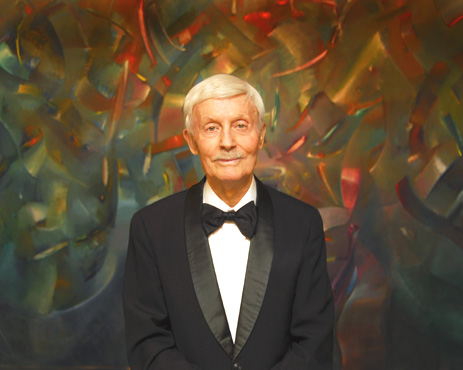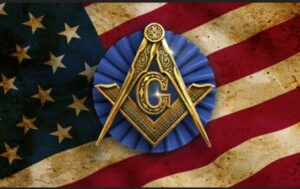The Mysterious Painting
By W:. Ronald J. Seifried, DSA
Walking around the antiquated rooms of Jephtha Lodge, I am constantly searching for clues that uncover forgotten memories, broaden the history of our lodge and its place in Huntington for over 160 years. Patience, determination, enthusiasm and, above all, curiosity are the main attributes of a lodge historian. Short of donning a dusty fedora and cracking a leather whip, the “fortune and glory” that many may envision is usually tempered by long hours of internet research. We need to “forget any ideas about lost cities, exotic travel, and digging up the world. We do not follow maps to buried treasure, and “X” never, ever marks the spot.”
But the “X” may be right in front of our faces everyday we walk into our lodge room.
Masonic lodge historical records sometimes suffer from the lack of detailed provenance of an artifact’s origins. It is exceedingly rare a lodge historian or trustee is trained in the skill of database management or basic record keeping. Many times, the historian will be required to pore over the thousands of pages of lodge-meeting-minute-books to uncover a brief detail from where a piece of the lodge history originated. Illegible handwritten notes aside, digital scanning documents does not alleviate the challenges in research, and an archivist would still need to implement optical character recognition (OCR) to enable the search function in a converted PDF document for more manageability.
But one recent discovery started a long path based on just one word, or in this specific case, one name.
On display in our lodge room for several years without any details of its origins is a 3’ x 2’painting that depicts the builders of King Solomon’s Temple. Simply signed on the bottom right corner “Gerard Tempest,” my interest in this unknown and overlooked piece got the best of me.
My first instinct was to look up the list of all Jephtha Lodge members dating to 1860 to see if we ever had a member with the name “Tempest.” When that option was exhausted, the next step was to photograph the painting with a closeup of the signature and resume the research on my home computer during my spare time.
My google search turned up an intriguing discovery, but it was so extraordinary, my skepticism restrained any premature enthusiasm. Gerard Francis Tempest (1918-2009) was a painter, sculptor and architect and is considered the father of Abstract Spiritualism. The painting the lodge has on display is far from any form of abstract art. Additional research led me to Gerard Tempest III’s widow, Connie, wife of the artist’s eldest son.
His widow referred me to her brother-in-law, John Tempest, an accomplished artist in his own right and a renowned expert of his father’s work. I doubted this painting was a Tempest original as it did not fall into his usual style of surrealism which kept my enthusiasm restrained, but I noticed some early portraits on his official website to which this piece may be similar.

John Tempest’s reply to my email and attached photos stunned me.
“Yes, it’s original. I can tell by his handwork and colorization. I assisted him in his last 20 years of painting. He painted it during the period we lived at the Villa Tempesta from 1959-66 in Chapel Hill NC. Next door to the Villa was a Masonic Temple that must have commissioned him.”
The Italian born Tempest, the protégé of Giorgio de Chirico, the forerunner of Surrealism, received the Gold Medal at the Cannes Art Festival in 1987 and was honored by the Holy See during the reign of Pope John Paul II. His work became a part of the permanent collection of the Vatican Museum in 1982 and 1990.

Tempest’s impressive resume also includes his time as an allied officer during World War II, serving under General Omar Bradley in the 82nd Airborne Division. Tempest fought in campaigns all over Europe, including Normandy on D-Day, the Battle of Hürtgen Forest, the Battle of the Bulge, and with the French Underground in the Liberation of Paris. One of the main characters in the film Is Paris Burning? (1966) is said to have been based on him. Tempest received the Bronze Star Medal in 1944 and designed the 101st Airborne Division’s insignia, the “Screaming Eagle”.
There are no records that Gerard Tempest was a Freemason. I reached out to University Lodge No. 408 A.F. & A. M. in Chapel Hill, North Carolina, the lodge located next to Tempest’s home, Villa Tempesta, between 1959-1966. Brothers of University No. 408 and I have started a correspondence but unfortunately has been delayed due to the current pandemic crisis which has prevented them from further research.
One Masonic brother shared an interesting hypothesis that this piece may not be a commissioned work. While most present members of University No. 408 may not remember when the lodge was originally built in 1960, it is known that it required major excavation for the building to be constructed at the same elevation next to the Villa Tempesta. The area also witnessed major road relocation during the early years of Tempest’s residency.

The brother continued, “Considering Mr. Tempest’s abilities as an artist, is it not possible, with all this going on around the Villa, he transposed the real into the surreal qualities of the painted temple’s construction?” The brother continued, “I remember the road project, but the Villa was under construction. I can see the connection between our lodge and the amazing painting. The realignment of Franklin Street was the end of the Village of Chapel Hill and the beginning of the Town of Chapel Hill as we know it today. I choose to believe that while the painting gives the appearance of surrealism it is Mr. Tempest’s view of his surroundings during that time. “
The mysterious painting has partly revealed itself to the members of Jephtha Lodge, but there are several unanswered questions. Was the painting commissioned by University Lodge No. 408? When was it painted? Was Tempest inspired by the construction around his villa when he was in North Carolina? How did the painting end up over 500 miles away at Jephtha Lodge in Huntington, New York? And was Gerard Tempest a freemason?
The mystery continues…
The post The Mysterious Painting appeared first on Jephtha.com.

